Growing Friends Spring Plant Sale
You are here
Growing Friends Spring Plant Sale
Plants propagated by the Growing Friends are offered for sale to the public at very popular plant sales in spring and autumn each year. The plants are propagated by the Growing Friends from material sourced from the Garden and the proceeds are used by the Friends to support the Botanic Gardens. Plants offered for the spring sale include the following grassland and woodland plants suitable for rockeries:
Blandfordia grandiflora (Large Christmas Bell)
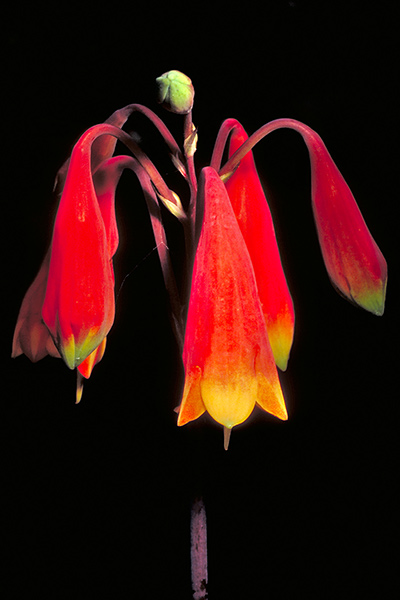
Brian Walters
Blandfordia grandiflora is a tufted perennial herb (without woody stems) with narrow leaves up to 70 centimetres long. The tubular flowers occur in groups of 6 or more about 30-60cm long. The flowers are quite large and typically red with a yellow tip but forms with all yellow flowers are also known. The flowers contain nectar and are frequented by honey eating birds. Flowering usually occurs in summer (December and January).
Blandfordia grandiflora is native to south-eastern Australia and can be found along the north and central coast of New South Wales and into Queensland although there are also populations on the north and central tablelands of New South Wales.
This is a popular plant in cultivation although it is very slow growing and easily "swamped" by more vigorous plants. It requires moist, well drained soils preferably of a light texture such as sandy loam. Some protection from the sun is preferable but it should not be grown in heavy shade. It is tolerant of at least moderate frosts. It is very suitable for growing in pots.
Propagation may be carried out from seed which can be slow to germinate.
Bulbine glauca (Bulbine Lily)
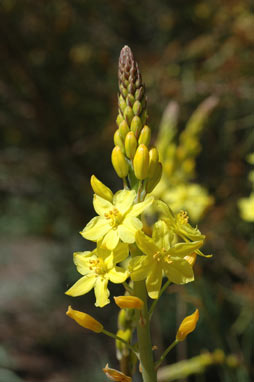
ANBG - M.Fagg
Bulbine glauca is a tufted perennial that grows to a height of about 50cm with thick, fleshy roots. The flowers are small, yellow and star-shaped, borne on spikes and faintly scented. The flowers can begin to open in spring and sometimes continue right through to autumn if the weather conditions are right and the plant receives regular water throughout the hot months.
Bulbine glauca occurs naturally in New South Wales, Victoria, Tasmania and possibly into Queensland. Its distribution is mostly associated with elevated areas, cliffs, crevices and summits, and along the Great Dividing Range in Victoria and New South Wales.
During the hot months, watering two to three times a week is required but allow to dry off afterwards. It is frost tolerant and is able to be grown in full sun to light shade and prefers a slightly protected area. It is an easy plant to propagate through self-seeding if it is grown in rich, well-drained, soil in an area that is regularly watered. Older plants can be propagated by division.
Calostemma purpureum (Garland Lily)
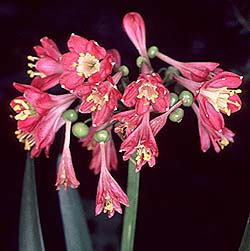
ANBG - M.Fagg
Calostemma purpureum occurs in western New South Wales, north-western Victoria and in South Australia and is a well-known plant of the Riverina district, on both flood plains and rocky ridges. The plant makes an ideal rockery subject, taking up very little space but extending its flowering stem high enough to become obvious. It prefers hot overhead sun to dappled light and ordinary soil improved by the application of slow release fertilizer.
Flowers appear each summer between January and March. Seeds germinate on the plant and should be sown in a well-drained mix, placed in a warm spot and protected from snails and slugs. It flowers best after dry periods so should be allowed to dry off after the leaves yellow.
The yellow flowered Calostemma luteum has been considered a synonym of C. purpureum by some botanists, but the Australian Plant Census recognises the two as distinct species. Both forms will be available for sale.
Microseris lanceolata (Yam Daisy; Murnong; Native Dandelion)

ANBG - C.Totterdell
Microseris lanceolata is native to southern parts of Australia, open forest, woodlands and grasslands. The perennial species has edible tuberous roots and was once an important source of food for the Indigenous people of mainland Australia and Tasmania. It was prepared by roasting or pit baking; the taste is described as ‘sweet with a flavour of coconut’.
It has tufted rosettes of lobed or toothed linear leaves with pendulous drooping buds opening to dandelion-like bright yellow flowers in spring and summer followed by a cluster of fluffy white seeds. Plants prefer well-drained soil in full sun or part shade and grow better in cooler climates. It is frost and drought tolerant.
Patersonia sericea (Silky Flag; Purple Flag; Native Iris)
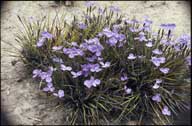
Brian Walters
Patersonia sericea is widespread from north-eastern Victoria to south-eastern Queensland in grassland, woodland and open forest. It is an attractive species for the garden in a well-drained, sunny or semi-shaded, moist position. The three-petalled flowers on stems which are shorter than the leaves, are deep blue or purple (occasionally white) and usually occur in spring and summer. Each flower opens for a single day but new flowers are produced over an extended period. The species is tolerant of at least moderate frost.
Propagation is relatively easy from seed which does not require any special pre-treatment. Division of large plants is also a successful method.
Dianella caerulea (Blue Flax Lily; Paroo Lily)
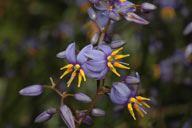
ANBG - M.Fagg
Dianella caerulea is a tufting perennial herb found across the eastern states of Australia and Tasmania. It occurs in a wide range of habitats, from coastal heathland and even sand dunes and grows to a height of 0.2-1m and a width of 0.3-2.5m. Flowers and fruit appear over summer, the flowers varying in colour between light and dark blue to mauve, with fruit being a rich translucent purple or cobalt, releasing an indigo stain when squeezed.
It spreads with underground rhizomes, is very hardy and long-lived once established and grows in full sun and well-drained soil. Kept well watered and mulched, it can tolerate dry and damp conditions.

